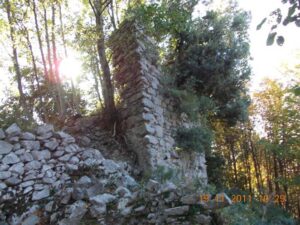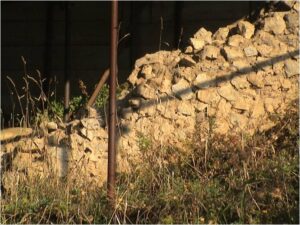MUNICIPALITY: Ravello
NAME: Chiesa di S. Trifone
LOCATION : Via Monte
DESCRIPTION : This church, attached to the oldest Benedictine monastery in Ravello, already existed in 1096. The entrance to the structure is placed on the side of the altar, although it can also be accessed from the opposite side, by passing through an atrium bordered by round, slightly lowered arches, on very low pillars.
The church has three naves, divided by five round arches on masonry pillars. The roof is cross-vaulted for the side naves and barrel-vaulted with lunettes for the central one; only the two side naves are apsidal.
The interior decoration consists of the remains of a fresco depicting a Madonna and the Divine Infant in the right apse, and a painting on the right pillar commemorating a grace received.
A small apsidal chapel, parallel to the right apse area, presents access from the right aisle.
The square bell tower shows two single-lancet windows on each side, emphasized by decorative motifs in tuff.
SEE, VISIT, FIND: The church is always closed; to visit it one must contact the pastor of the church of St. Mary of Lacco, a fraction of Ravello.
FRUITION DATA: None
OPPORTUNITIES: The structures could be presented with exterior panels, so the church is always usable for visitors. Similar evidence, often little known, would be better enhanced by a tour itinerary (possibly guided) dedicated to the religious architecture of Ravello.
BIBLIOGRAFIA: FULCHIGNONI G., Ravello. Le cento chiese, Amalfi 2001
IMPERATO G., Ravello nella storia civile e religiosa, Cava d. T. 1990
MANSI L., Ravello sacra-monumentale, Ravello 1887
CHIESA DI SAN TRIFONE
“Ora et labora”The church dedicated to St. Trifone, in the upper part of Ravello’s urban center, is connected to the oldest Benedictine abbey founded in Ravello. Dedicated to the Great Mother of God and to the two saints Trifone and Biagio, the abbey stood along the only access road to Ravello from the most important centers of the Vesuvian area and therefore certainly played, in addition to a religious role, also a political one and one of control over the territory. The importance of this place is also demonstrated by the fact that the first two bishops of Ravello, Orso Papice and Costantino Rogadeo – to whose initiative we owe the ambo, called Rogadeo, the oldest present in the town’s main church – came from this abbey.
At present nothing survives of the abbey but the church, which has three naves, with the floor rising slightly toward the altar, which is in a slightly elevated transept.
A fresco on a left pillar commemorates a grace received, while another fresco depicts in the right apse the Madonna and Divine Infant. The roofing of the nave is represented by a barrel vault, which replaced a double-pitched roof in ancient times, as attested by the profile of the facade, and by cross vaults in the side naves.
The decoration of the bell tower, which consists of thin columns and motifs made of tufa, is interesting, as is the presence, inside the church, of the ancient clock mechanism.
The church is preceded by a portico that can be considered the only surviving sign of the ancient abbey.





